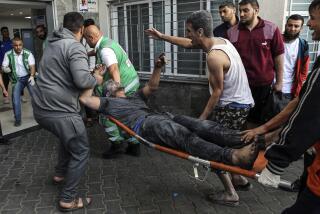The War That Went Right
- Share via
The intelligent use of “smart” bombs and the judicious deployment of U.S. troops have helped Afghan fighters lay the groundwork to rebuild a once insignificant but suddenly strategic nation. That does not mean the end of the war on terrorism--far from it--but it does mean that the valid doubts and exaggerated worries about going to war half a world away against an elusive enemy are put to rest. So far the U.S.-led campaign that began to form Sept. 11 must be judged successful.
U.S. Army helicopters provided transportation early in the war for the man who now is Afghanistan’s temporary prime minister, Hamid Karzai. Green Berets helped him forge a fighting force to battle the Taliban in the south. In the north, U.S. special operations forces aided warlord Abdul Rashid Dostum and other fighters of the Northern Alliance. In vehicles, from manned and unmanned aircraft circling above and on foot atop mountain ridges, U.S. military spotters identified Taliban convoys and called in airstrikes with impressively devastating precision. As in all wars, errant bombs killed civilians and friendly soldiers. But the overall picture is one of leading-edge technology in the hands of well-trained U.S. fighters.
The use of Green Berets, other special operations troops and Marine expeditionary forces impressed on Afghans that the United States was willing to send its own fighters into harm’s way to root out Osama bin Laden’s Al Qaeda terrorists and the Taliban regime protecting them. Foes had claimed that while the U.S. was willing to bomb from 15,000 feet, it was unwilling to fight man to man. Some cited as evidence the 1993 U.S. pullout from Somalia after the bodies of American personnel killed there were dragged through the streets. That reasoning overlooked the resolve of a nation that had suffered the deaths of nearly 3,000 people in terrorist attacks.
The Taliban, welcomed five years ago when it promised peace and security, ended up with little support from those it ruled so fanatically. With its air defenses shattered, its opponents well armed and the citizenry unwilling to help, soldiers who once swept through the country nearly unchallenged were easily defeated. The U.S. determination to build and retain an international coalition further isolated the Taliban and Al Qaeda.
The Afghanistan campaign has proven the worth of well-equipped, highly trained and mobile U.S. special forces, able to speak the local language and help local soldiers. That is a strong argument for a reorganization of the military to make the best use of agile, mobile troops, unmanned aircraft and laser-guided weapons. However, the troops were aided by fighter planes launched from aircraft carriers. The massive ships, criticized before Sept. 11 as expensive and vulnerable, showed their value when there are no nearby land bases.
Although the military campaign turned out to be easier than many expected, rebuilding the country and getting brutal warlords like Dostum, now the deputy defense minister, to rule cooperatively remain tough challenges. But with international help and the same determination shown in the war, the Afghans can succeed.
More to Read
Sign up for Essential California
The most important California stories and recommendations in your inbox every morning.
You may occasionally receive promotional content from the Los Angeles Times.













